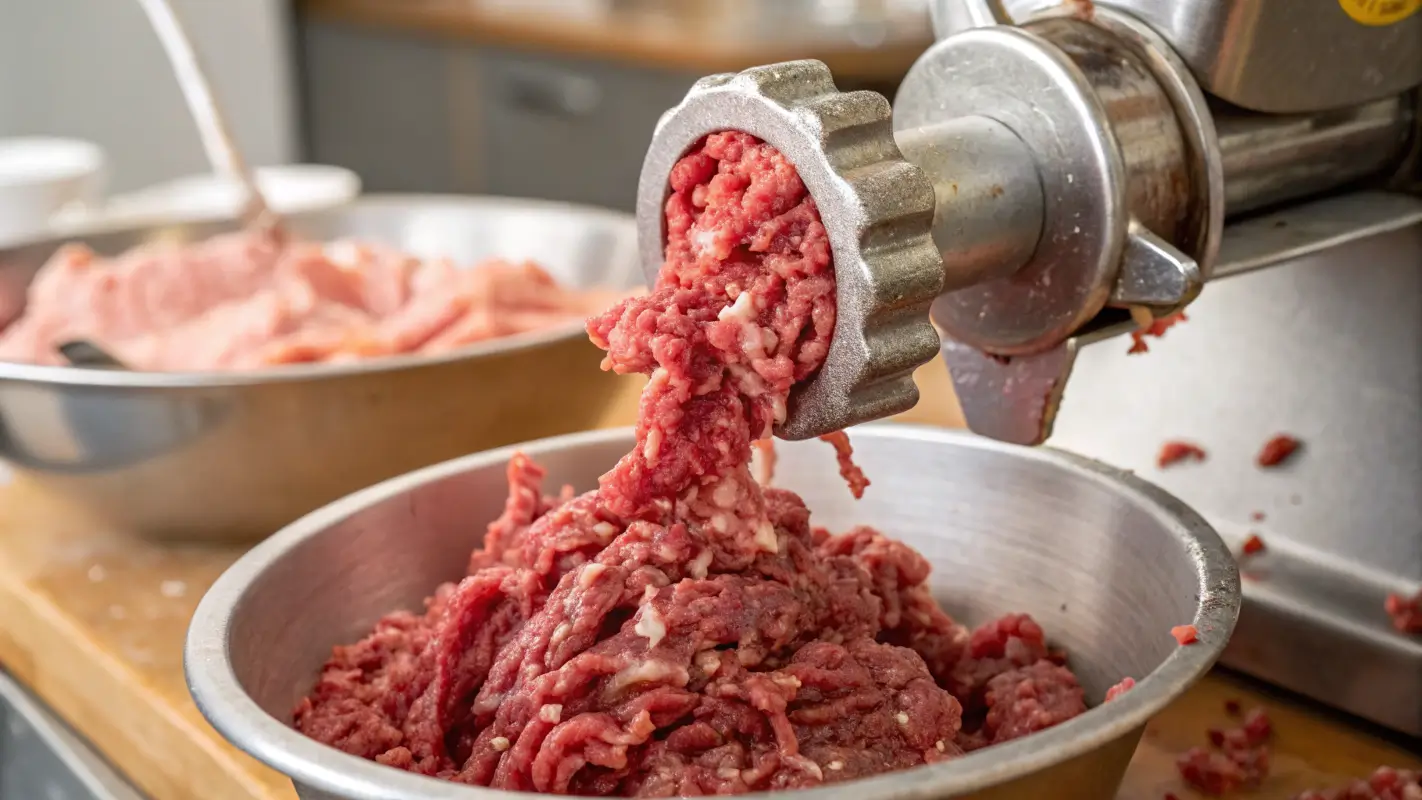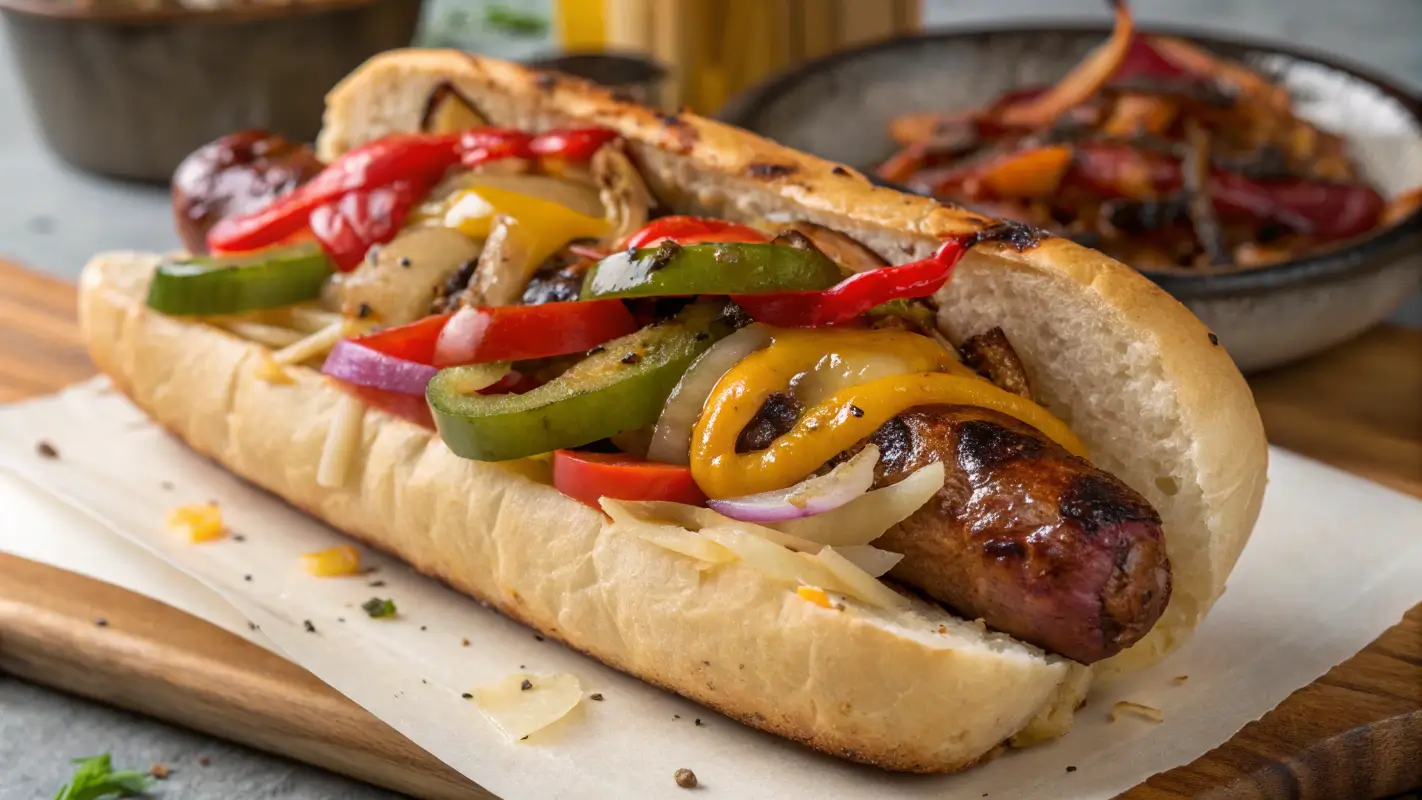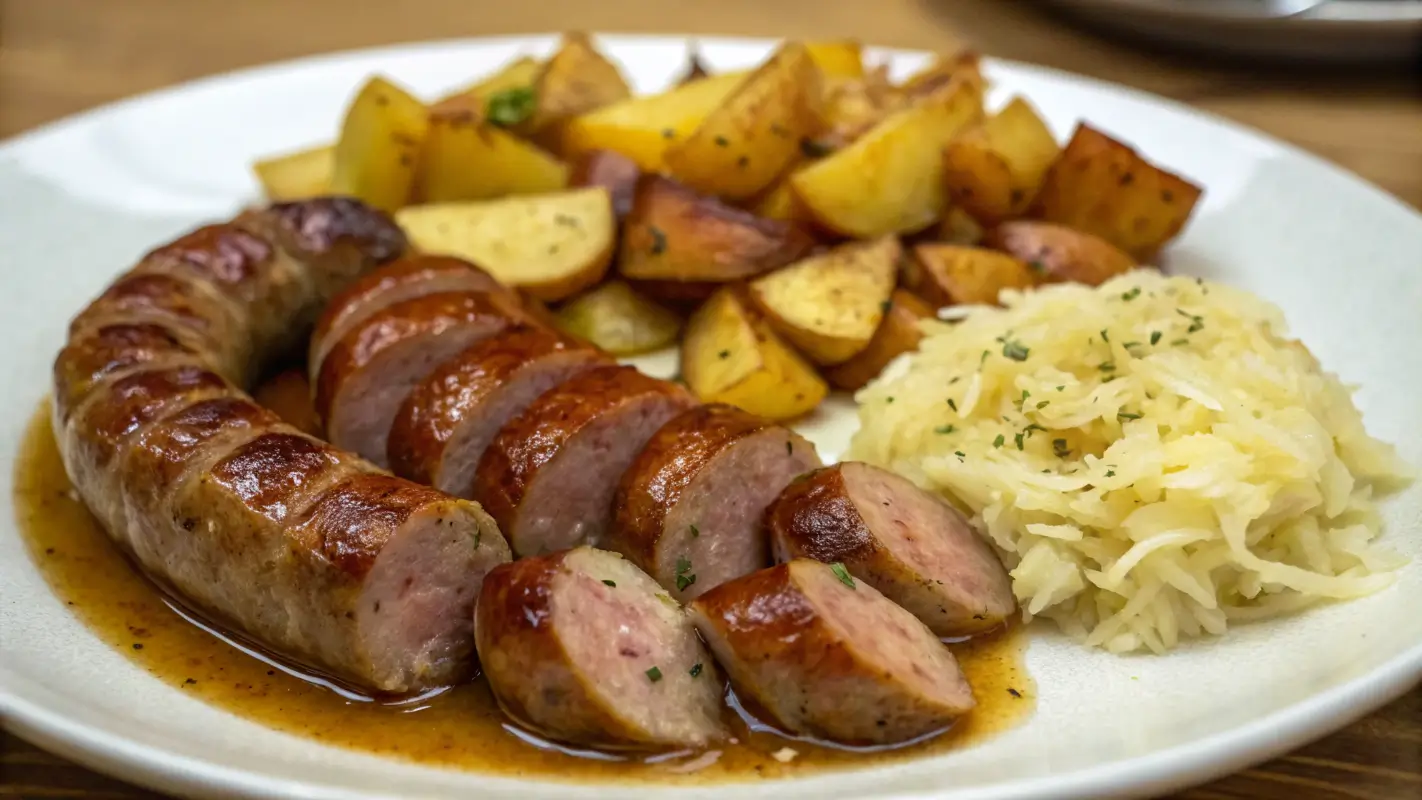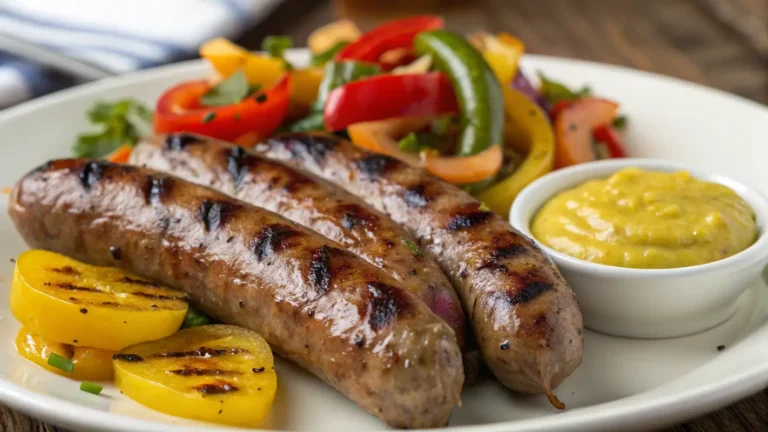Contents
Introduction to Beef Sausage
What is Beef Sausage?
Beef sausage is a type of sausage made primarily from ground beef, although other ingredients, such as fat, seasonings, and herbs, are often mixed in to enhance flavor. While sausages can be made from a variety of meats, beef sausage is a popular choice because of its rich, juicy taste and versatility.
Historically, sausages were created as a way to preserve meat and use every part of the animal. Over the centuries, beef sausage has evolved from a method of meat preservation to a beloved food enjoyed in various cuisines worldwide. Today, it’s often enjoyed as a breakfast item, part of a hearty meal, or even as a snack.
Nutritional Benefits of Beef Sausage
One of the standout features of beef sausage is its high protein content. A single serving provides a generous amount of protein, which is essential for muscle repair and overall bodily functions. Additionally, beef sausage is a good source of essential vitamins and minerals, including iron, zinc, and B vitamins like B12. These nutrients support immune health, energy production, and cognitive function.
However, like any sausage, beef sausage can be high in fats and calories, depending on how it’s made. So, moderation is key! If you’re aiming for a leaner option, you can choose sausages made with a higher ratio of lean beef, or even opt for alternatives like turkey or chicken sausages.
Beef sausage also offers a satisfying taste experience, often featuring bold flavors from spices such as black pepper, paprika, garlic, and more. Whether spicy or mild, the seasoning blends create a savory experience that pairs beautifully with a variety of dishes.
Making Beef Sausage
How is Beef Sausage Made?

Making beef sausage is an art that starts with selecting the right beef. The process begins by grinding the beef, typically using a meat grinder or a food processor. The beef is cut into chunks and passed through the grinder, creating a ground mixture that serves as the base of the sausage. This mixture can be finely or coarsely ground, depending on the texture you’re aiming for. Often, fat is included in the mix to ensure the sausage remains juicy and flavorful.
While chuck roast or brisket is often used for its ideal fat-to-meat ratio, have you ever considered the unique flavor and tenderness of beef cheek meat? This cut adds richness and depth to your sausages. If you’re interested in exploring how beef cheek meat can enhance your cooking, take a closer look at this beef cheek meat guide.
Once the beef is ground, it’s time for the seasoning. Herbs, spices, and other flavorings are mixed into the meat. Some common seasonings include garlic, black pepper, paprika, oregano, and cayenne pepper. The seasoning blend can vary based on regional preferences or personal taste, but the goal is to infuse the meat with rich, savory flavors.
Next, the sausage mixture is stuffed into casings. Casings act as the outer shell that holds the sausage together while it cooks. They come in two primary types: natural and synthetic. Natural casings are made from the intestines of animals like pigs, cows, or sheep, while synthetic casings are made from cellulose or collagen. Each type of casing affects the texture and appearance of the sausage, so choosing the right one is essential.
Once stuffed, the sausages can be tied into links and ready for cooking. They can be either pre-cooked or raw, depending on how they will be prepared.
Beef Sausage Recipes

Sausage recipes can range from traditional to modern, depending on how adventurous you’re feeling in the kitchen. Traditional beef sausage recipes usually follow a classic seasoning mix, with a focus on salt, pepper, and sometimes a touch of sugar. Some variations include the addition of onions, garlic, or herbs like parsley and thyme.
Modern recipes, on the other hand, might experiment with bolder flavors, including spicy jalapeños, ginger, or curry powder. Some cooks even add cheese or apple to create unique flavors that make each bite a new experience.
By adjusting the seasoning and fat content, the texture and flavor of the beef sausage can be completely transformed. It’s all about finding the perfect balance of spices and seasonings that suit your personal preferences.
If you’re looking for more ways to incorporate flavorful ingredients into your meals, you might enjoy this Lipton Onion Soup Meatloaf recipe, which offers a delicious twist on a classic dish.
Tips for Making Perfect Beef Sausage at Home
Making beef sausage at home is a fun and rewarding experience, but it does require some attention to detail. One of the first things to consider is choosing the right cuts of beef. To make a good sausage, you’ll want to use a combination of lean and fatty cuts. Chuck roast or brisket are excellent options because they provide enough fat content to keep the sausage moist and flavorful.
Maintaining the right texture is also essential. Overmixing the meat can lead to a dense and tough sausage, while undermixing may result in an uneven texture. Be sure to mix the ingredients just until everything is well combined. It’s also important to chill the meat mixture in the refrigerator for at least 30 minutes before stuffing it into casings. This helps the mixture firm up and makes it easier to work with.
Finally, avoid common mistakes like using too much salt or not seasoning enough. If you’re new to making sausages, it’s a good idea to start with a small batch and adjust the seasonings until you get the flavor you love. And don’t forget to test your sausage by cooking a small piece before you prepare the entire batch to make sure the seasoning is just right.
Popular Types of Beef Sausage
When it comes to beef sausage, there’s no shortage of variety. From traditional breakfast options to bold international flavors, there’s a beef sausage for every palate.
Breakfast Sausages
One of the most popular types of beef sausage is the breakfast sausage. Typically, this sausage is made with a fine grind of beef, seasoned with a mix of sage, black pepper, and sometimes sugar. It’s small in size and often served alongside eggs, toast, or pancakes. The savory and slightly sweet taste makes it a favorite at breakfast tables.
Italian Beef Sausages
Italian beef sausage is another well-loved variation, commonly made with ground beef and seasoned with a mix of fennel, garlic, and oregano. This sausage is often used in Italian dishes such as pasta, sandwiches, and pizza. The bold and aromatic flavors of Italian sausage come from the careful blend of spices that highlight its Mediterranean roots.
Chorizo Beef Sausages
If you’re craving something with a bit of heat, chorizo beef sausage delivers just that. This variety, often made with a coarser grind of beef, is heavily seasoned with paprika, chili powder, garlic, and other spices that create a flavorful kick. Whether used in tacos, scrambled eggs, or grilled as a standalone dish, chorizo beef sausage brings excitement to any meal.
Kielbasa Beef Sausages
Kielbasa, or Polish sausage, is another popular beef sausage variety that is smoked and flavored with garlic, marjoram, and pepper. It’s typically made with a blend of beef and pork (though beef-only options exist) and can be grilled, boiled, or used in stews. This sausage is especially famous in Eastern European cuisine and has a savory, slightly smoky flavor.
If you’re interested in experimenting with other sausage varieties, consider trying this Venison Breakfast Sausage Recipe, which offers a unique twist on the traditional breakfast sausage!
Regional Variations of Beef Sausage
Sausages vary greatly by region, and the differences are often a reflection of local tastes and available ingredients.
American vs. European Sausages
In America, beef sausages tend to be more heavily spiced and are often served as part of a hearty breakfast. They also vary in shape and texture, depending on the region—New Orleans has its famous Andouille sausage, which is often smoked and used in gumbo, while the Midwest is known for its bratwurst.
In Europe, sausages are often more finely ground and carefully seasoned with a blend of herbs and spices specific to each country. German sausages may contain more herbs like thyme and marjoram, while French sausages may incorporate ingredients like wine and garlic. European sausages are typically more diverse in flavor profiles and are commonly paired with sauerkraut or mustard.
Differences in Flavors and Textures
The flavor and texture of beef sausage can also differ widely based on the region and the method of preparation. For example, sausages made in the Mediterranean often have a lighter, more aromatic flavor, while those made in South America (like Argentinian chorizo) may have a smoky and robust taste due to the use of charcoal grilling.
The texture can range from finely ground and smooth to coarser and chunkier, depending on the grinding method and the amount of fat used in the recipe.
Cooking and Serving Beef Sausage
How to Cook Beef Sausage?
Cooking beef sausage is straightforward, but there are a few key things to keep in mind to ensure your sausages come out flavorful and perfectly cooked.
Grilling vs. Pan-Frying
When it comes to cooking methods, grilling and pan-frying are two of the most popular options for beef sausage.
-
Grilling: Grilling beef sausage is a fantastic choice if you’re aiming for that smoky, charred flavor. The heat from the grill helps render the fat, keeping the sausage juicy. Preheat the grill to medium-high heat, and place the sausages on the grill. Turn them regularly to avoid burning, and cook until they are browned and reach an internal temperature of 160°F (71°C). Grilling imparts a crispy exterior while keeping the inside tender.
-
Pan-Frying: If you don’t have access to a grill or simply prefer to use the stovetop, pan-frying is an excellent alternative. Heat a pan over medium heat, and add a bit of oil to prevent sticking. Place the sausages in the pan and cook them for about 10-12 minutes, turning occasionally to ensure even cooking. This method also creates a crispy exterior but may require a little more attention to avoid burning.
Cooking Times and Temperatures
No matter how you choose to cook your beef sausage, it’s important to monitor the internal temperature to ensure they’re fully cooked. The USDA recommends cooking sausages to an internal temperature of 160°F (71°C). Using a meat thermometer is the easiest way to check. If you’re grilling, be sure to use indirect heat once the sausages are browned to avoid overcooking the outside while ensuring the inside cooks thoroughly.
If you’re cooking beef sausage in a skillet, be mindful not to over-crowd the pan. Doing so can cause the sausages to cook unevenly. Allow enough space for them to brown properly on all sides.
Beef Sausage Serving Ideas

Once your beef sausages are cooked to perfection, the fun begins with creative ways to serve them. Here are some mouthwatering serving ideas:
Pairings with Sides and Condiments
Beef sausages are incredibly versatile and can be paired with a variety of sides and condiments to enhance their flavor. Consider serving them with crispy roasted potatoes, sautéed vegetables, or even a fresh, tangy salad. For a heartier meal, pair them with mashed potatoes or macaroni and cheese.
Condiments like mustard, ketchup, or a spicy sriracha sauce can add an extra kick, while sauerkraut or coleslaw provides a refreshing balance. The tanginess of pickled vegetables complements the richness of the sausages, making for an irresistible combination.
Creative Recipes (e.g., Sausage Sandwiches, Casseroles)
For a more elaborate meal, consider using beef sausages in creative dishes like sausage sandwiches, where you can pile grilled sausages onto a bun with your favorite toppings. Add sautéed onions, peppers, or cheese for an extra flavor boost. A classic sausage sandwich can be dressed up with a bit of mayo or mustard.
Alternatively, beef sausages can shine in casseroles. Slice the sausages and layer them in with potatoes, vegetables, and cheese for a comforting, one-pan dish. You can even add the sausages to a tomato-based sauce for a hearty Italian-style casserole or stew.
Beef sausages are also great for adding to pasta dishes. Try slicing them and mixing them into a rich tomato sauce or creamy alfredo sauce for a filling meal.
Health and Safety Considerations
Is Beef Sausage Healthy?
While beef sausage is undoubtedly delicious, its nutritional profile can vary depending on how it’s made. It’s high in protein, which is essential for muscle repair and immune function, and it’s also a source of important nutrients like iron and B vitamins.
However, it’s important to keep in mind that beef sausage can be high in fats, especially saturated fat. This means that while it can be a part of a healthy diet, it should be consumed in moderation.
For those looking to make healthier choices, consider opting for sausages made with leaner cuts of beef or those that are lower in fat. You can also look for lower-sodium varieties to keep your sodium intake in check. If you’re following a specific diet, such as a low-carb or high-protein plan, beef sausages can fit in well when consumed in moderation.
Additionally, always check the labels when purchasing pre-made sausages, as they may contain added preservatives, artificial flavorings, or fillers.
The Role of Beef Sausage in a Balanced Diet
Incorporating beef sausage into a balanced diet is about being mindful of portions and pairing it with a variety of nutritious foods like vegetables, whole grains, and fruits. Instead of making beef sausage the centerpiece of every meal, try using it as an accent to add flavor to dishes. Whether in casseroles, pasta, or sandwiches, a small amount of sausage can go a long way.
Food Safety Tips for Beef Sausage
Proper handling and cooking of beef sausage are essential for ensuring it’s safe to eat. Here are a few important food safety tips:
Safe Handling and Storage
- Always store beef sausage in the refrigerator until you’re ready to cook it. If you’re not planning to cook it within a couple of days, consider freezing the sausages to maintain freshness.
- If you’re working with raw sausages, wash your hands thoroughly after handling them. Clean any utensils, cutting boards, and surfaces that come into contact with raw meat.
Cooking Beef Sausage to the Right Internal Temperature
As mentioned earlier, the internal temperature of beef sausage should reach 160°F (71°C) to ensure it’s safe to eat. Use a meat thermometer to check the temperature before serving. This is especially important if you’re cooking sausages on a grill or in a skillet, as they may appear brown on the outside before they’re fully cooked on the inside.
By following these safety tips and cooking your beef sausages correctly, you can enjoy a delicious and safe meal every time.
FAQs
As beef sausage continues to grow in popularity, many people have questions about how to best prepare and enjoy it. Below are answers to some of the most commonly asked questions about beef sausage.
What is the best cut of beef for sausage?
The best cuts of beef for making sausage typically come from the tougher parts of the cow, as these cuts have the right balance of fat and meat needed to create a juicy and flavorful sausage. Some popular cuts include:
- Chuck roast: Known for its perfect fat-to-meat ratio, chuck roast provides a great base for sausage.
- Brisket: This cut is another excellent option, offering a robust beef flavor and enough fat to keep the sausage moist.
- Round: While leaner than chuck, adding some fat (either from pork or beef fatback) can help improve the texture and flavor.
When making beef sausage, it’s important to use a combination of lean cuts and fat to achieve the desired flavor and texture.
Can you freeze beef sausage?
Yes, you can freeze beef sausage! If you have leftover sausages or if you’ve made a big batch in advance, freezing is a great way to preserve them for later use. Simply place the sausages in an airtight container or freezer bag, ensuring they are well-wrapped to prevent freezer burn. You can store raw or cooked beef sausage in the freezer for up to three months.
To thaw, transfer the sausages to the refrigerator for 24 hours before cooking. Alternatively, you can defrost them using the microwave, though this may impact the texture slightly.
How long should beef sausage be cooked?
The cooking time for beef sausage depends on the method you’re using. Here’s a general guideline for cooking:
- Grilling: Cook the sausages over medium heat for about 12-15 minutes, turning occasionally until the internal temperature reaches 160°F (71°C).
- Pan-frying: Sausages typically take around 10-12 minutes on the stovetop over medium heat. Make sure to turn them regularly to ensure they cook evenly and reach the right temperature.
- Baking: If you prefer baking, place the sausages in a preheated oven at 375°F (190°C) for 20-25 minutes, flipping halfway through.
Regardless of the cooking method, always check the internal temperature with a meat thermometer to ensure your beef sausage is cooked through.
Is beef sausage gluten-free?
Most beef sausages are naturally gluten-free, as they are made from beef, spices, and seasonings. However, some commercially made sausages may contain gluten due to added fillers or ingredients used to bind the meat, such as breadcrumbs or wheat-based products.
To ensure your beef sausage is gluten-free, always check the ingredient list on the packaging or make your own at home using 100% beef and gluten-free seasonings. If you have a gluten sensitivity, it’s always safer to go for sausages labeled as “gluten-free.”
Print
Homemade Beef Sausage
This homemade beef sausage recipe is packed with savory flavor and perfectly spiced for a mouthwatering meal. Perfect for grilling, pan-frying, or adding to your favorite dishes!
- Total Time: 45 minutes
- Yield: 8-10 sausages 1x
Ingredients
- 2 lbs ground beef (preferably chuck or brisket)
- 1/2 cup crushed ice
- 2 tbsp kosher salt
- 1 tsp black pepper
- 1 tsp garlic powder
- 1 tsp onion powder
- 1 tsp paprika
- 1/2 tsp red pepper flakes (optional for a spicy kick)
- 1/4 cup fresh parsley, chopped
- Sausage casings (if making links)
Instructions
- Start by placing the ground beef in a large mixing bowl. Add the crushed ice to the meat to keep it cold throughout the mixing process.
- In a separate bowl, combine the kosher salt, black pepper, garlic powder, onion powder, paprika, and red pepper flakes. Mix the spices well.
- Sprinkle the spice mixture evenly over the ground beef. Add the chopped parsley and mix everything together by hand until fully combined.
- If you’re using sausage casings, soak them in warm water for about 30 minutes to make them pliable. Rinse thoroughly before using.
- Stuff the beef mixture into the sausage casings, ensuring they are packed tightly. Tie off the ends with butcher’s twine.
- For those not using casings, you can form the sausage into patties instead.
- Heat your grill or skillet to medium heat. Cook the sausages for about 10-12 minutes, turning occasionally, until the internal temperature reaches 160°F (71°C).
- Remove from heat and let rest for a few minutes before serving.
Notes
- If you’re using casings, make sure not to overstuff them, as this can cause them to burst during cooking.
- You can freeze uncooked sausages for up to three months for later use. Just make sure they’re well-wrapped.
- Prep Time: 15 minutes
- Cook Time: 30 minutes
- Category: Main Course
- Method: Grilling
- Cuisine: American
- Diet: Gluten Free
Nutrition
- Serving Size: 1 sausage link or patty
- Calories: 250
- Sugar: 1g
- Sodium: 800mg
- Fat: 22g
- Saturated Fat: 8g
- Unsaturated Fat: 12g
- Trans Fat: 0g
- Carbohydrates: 1g
- Fiber: 0g
- Protein: 18g
- Cholesterol: 60mg
Keywords: beef sausage recipe, homemade sausages, grilling beef sausages, homemade sausage links, keto beef sausage






Yummy
★★★★★